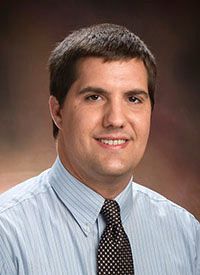Article
Antibody-Drug Conjugate Could Lead to Treatment Advances in Pediatric Neuroblastoma
Author(s):
Kristopher R. Bosse, MD, discusses how D3-GPC2-PBD could impact pediatric neuroblastoma.
Kristopher R. Bosse, MD

Kristopher R. Bosse, MD
An antibody-drug conjugate targeting the GPC2 molecule could have potential in pediatric patients with neuroblastoma, according to recent preclinical data.
D3-GPC2-PBD, an antibody-drug conjugate that links a specific GPC2-targeting antibody to the potent DNA-damaging pyrrolobenzodiazepine dimers, potently eradicated genomically diverse neuroblastoma patient-derived xenografts. The data were presented at the 2018 AACR Annual Meeting.
Treatment with D3-GPC2-PBD resulted in complete and sustained tumor regression up to 100 days in 61% of mice treated with a 1 mg/kg dose, 96% of those treated with the 3 mg/kg dose, and 95% of mice treated with 1 mg/kg of D3-GPC2-PBD given twice weekly for 2 weeks.
Moreover, tumors treated with D3-GPC2-PBD showed significant upregulation of DNA damage and apoptosis by immunohistochemistry. The antibody-drug conjugate was well tolerated with no discernible drug-related toxicities.
The lead investigator of the study, Kristopher R. Bosse, MD, said this could be a breakthrough in the field, because identifying molecular targets has proven difficult in neuroblastoma.
OncLive: Please provide some background to this study.
What were the results with this agent and what are the clinical implications?
What are the next steps?
What do you think about the current state of therapy in pediatric cancer?
In an interview with OncLive, Bosse, a pediatric oncologist at the Children’s Hospital of Philadelphia, discussed how D3-GPC2-PBD could impact pediatric neuroblastoma.Bosse: We used a large sequencing data set to identify differently expressed genes in neuroblastoma and not normal tissues. This molecule, called GPC2, was identified in this approach. We built a very potent antibody-drug conjugate, where we pick a specific GPC2 antibody and link it to a DNA-damaging drug. The antibody is selectively targeted to this tumor by this molecule, then it's taken up into the cells and the drug is released. The tumors eventually will die.The abstract we presented here is a continuation of this work and using this antibody-drug conjugate in a panel of neuroblastoma patient-derived xenografts that differ in both their expression of this molecule and their genomic characteristics that are common in neuroblastoma. What we found is that the antibody-drug conjugate is effective across this panel, both in neuroblastoma and other cancers that express this molecule. It's the basis of preclinical work that we hope to now build into a clinical trial.We're working with several companies and view this as a tool compound. We need to still work with this antibody and other drugs and find out what the best combination is. We can look at it in neuroblastoma and other cancers.In pediatric and adult cancers, we are all really excited about immunotherapy. In pediatrics, when we think about immunotherapy, we're really talking about antibody-based therapies, antibody-drug conjugates, or CAR T cells. What we are learning in pediatrics is that there's a lot of molecules we've yet to discover, and GPC2 is one of the first that we've really gone from discovery to new therapies. We're pretty excited about that. There's a lot of molecules that we're yet to begin to explore. This is just the tip of the iceberg.
What is the current standard for pediatric patients with neuroblastoma?
Then comes the hard work of trying to figure out what the best therapy is for every molecule and in every type of cancer. It could be that antibody-drug conjugates are better for solid tumors, or maybe chimeric antigen receptor (CAR) T-cell therapies will be more ideal. Either way, we still have a lot to learn.It's complicated. When we sit down with a family after diagnosing their child with high-risk neuroblastoma, we'll sort of spell out the therapy. It's about 1.5 to 2 years of therapy. [We give them] any type of anticancer therapy that we know of—chemotherapy, surgery, radiation, and then transplant. Now immunotherapy has come into the standard of care.
That brings up dinutuximab (Unituxin). It has a lot of side effects that really cripple a child if they're treated with it. They get a lot of pain. It's really just a long and involved treatment that the families go through wonderfully, but it's pretty intense.
How has the introduction of CAR T-cell therapy affected the landscape?
Is there anything else you would like to add?
Therefore, we hope to get better at giving targeted therapies or immunotherapies that have less side effects. Even in the patients who we're able to cure with this 2-year therapy, we usually leave them with sort of life-altering morbidities. There is room to do better. Currently, we only cure about 50% of children diagnosed with this disease.It's amazing, actually. At the Children's Hospital of Philadelphia, we get a lot of referrals for CD19-targeted therapy. It's been revolutionary for relapsed leukemias. Now the challenges we're trying to tackle are implementing effective CAR T-cell therapy into pediatric solid tumors. It's not going to be as easy as some of these readily available leukemias.One of the biggest challenges, as we just mentioned, is determining what the best immunotherapy for pediatric solid tumors is. CD19 is sort of the gold standard. We're learning very quickly that there's a few other molecules like that in pediatric cancers. Something else we're learning is that the cancer is very apt to creating resistance mechanisms.
Bosse KR, Zhu Z, Lane M, et al. The antibody-drug conjugate D3-GPC2-PBD potently eradicates neuroblastoma patient-derived xenografts. In: Proceedings from the 2018 AACR Annual Meeting; April 14-17, 2018; Chicago, Illinois. Abstract 4636.







